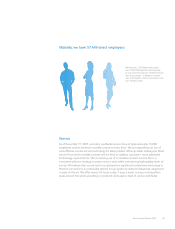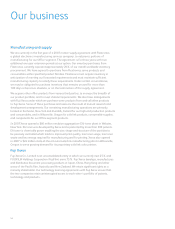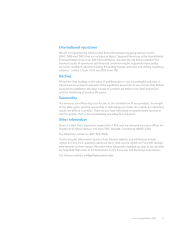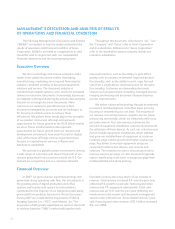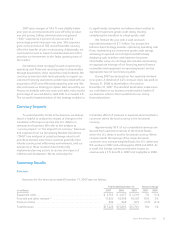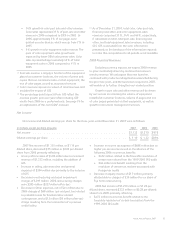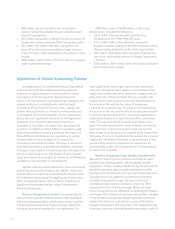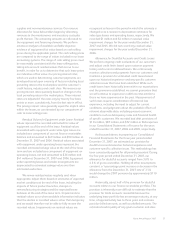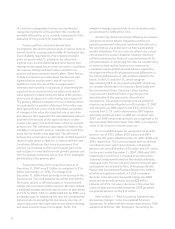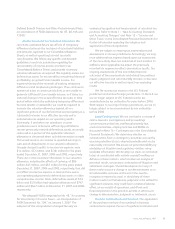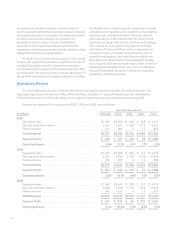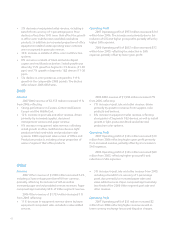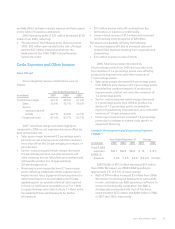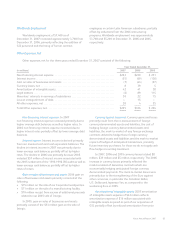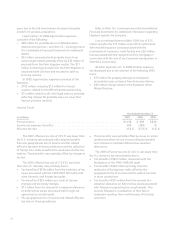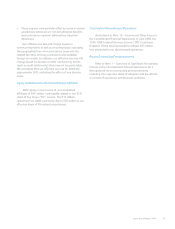Xerox 2007 Annual Report Download - page 60
Download and view the complete annual report
Please find page 60 of the 2007 Xerox annual report below. You can navigate through the pages in the report by either clicking on the pages listed below, or by using the keyword search tool below to find specific information within the annual report.of customer or geographic location can significantly
change during the life of the portfolio. We consider all
available information in our quarterly assessments of the
adequacy of the provision for doubtful accounts.
Pension and Post-retirement Benefit Plan
Assumptions: We sponsor pension plans in various forms in
several countries covering substantially all employees who
meet eligibility requirements. Post-retirement benefit
plans cover primarily U.S. employees for retirement
medical costs. Several statistical and other factors that
attempt to anticipate future events are used in calculating
the expense, liability and asset values related to our
pension and post-retirement benefit plans. These factors
include assumptions we make about the discount rate,
expected return on plan assets, rate of increase in
healthcare costs, the rate of future compensation
increases and mortality. For purposes of determining the
expected return on plan assets, we utilize a calculated
value approach in determining the value of the pension
plan assets, as opposed to a fair market value approach.
The primary difference between the two methods relates
to a systematic recognition of changes in fair value over
time (generally two years) versus immediate recognition
of changes in fair value. Our expected rate of return on
plan assets is then applied to the calculated asset value to
determine the amount of the expected return on plan
assets to be used in the determination of the net periodic
pension cost. The calculated value approach reduces the
volatility in net periodic pension cost that can result from
using the fair market value approach. The difference
between the actual return on plan assets and the expected
return on plan assets is added to, or subtracted from, any
cumulative differences that arose in prior years. This
amount is a component of the net actuarial gain or loss
and is subject to amortization to net periodic pension cost
over the average remaining service lives of the employees
participating in the pension plan.
Total actuarial losses for our pension plans as of
December 31, 2007 were $1 billion, as compared to $1.6
billion at December 31, 2006. The change from
December 31, 2006 relates primarily to an increase in the
discount rate. The total actuarial loss will be amortized in
the future, subject to offsetting gains or losses that will
change the future amortization amount. We have utilized
a weighted average expected rate of return on plan assets
of 7.6% for 2007, 7.8% for 2006 and 8.0% for 2005, on a
worldwide basis. In estimating this rate, we considered the
historical returns earned by the plan assets, the rates of
return expected in the future and our investment strategy
and asset mix with respect to the plans’ funds. The
weighted average expected rate of return on plan assets
we will utilize for 2008 will be 7.6%.
Another significant assumption affecting our pension
and post-retirement benefit obligations and the net
periodic pension and other post-retirement benefit cost is
the rate that we use to discount our future anticipated
benefit obligations. The discount rate reflects the current
rate at which the pension liabilities could be effectively
settled considering the timing of expected payments for
plan participants. In estimating this rate, we consider rates
of return on high quality fixed-income investments
included in various published bond indexes, adjusted to
eliminate the effects of call provisions and differences in
the timing and amounts of cash outflows related to the
bonds. In the U.S. and the U.K., which comprise
approximately 80% of our projected benefit obligations,
we consider the Moody’s Aa Corporate Bond Index and
the International Index Company’s iBoxx Sterling
Corporate AA Cash Bond Index, respectively in the
determination of the appropriate discount rate
assumptions. The weighted average rate we utilized to
measure our pension obligation as of December 31, 2007
and calculate our 2008 expense was 5.9%, which is an
increase from 5.3% used in determining 2007 expense.
Assuming settlement losses in 2008 are consistent with
2007, our 2008 net periodic pension cost is expected to be
approximately $40 million lower than 2007, primarily as a
result of the increase in the discount rate.
On a consolidated basis, we recognized net periodic
pension cost of $315 million, $425 million, and $414
million for the years ended December 31, 2007, 2006 and
2005, respectively. The costs associated with our defined
contribution plans, which are included in net periodic
pension cost, were $80 million, $70 million and $71 million
for the years ended December 31, 2007, 2006 and 2005,
respectively. Pension cost is included in several income
statement components based on the related underlying
employee costs. Pension and post-retirement benefit plan
assumptions are included in Note 14-Employee Benefit
Plans in the Consolidated Financial Statements. Holding
all other assumptions constant, a 0.25% increase or
decrease in the discount rate would change the 2008
projected net periodic pension cost by $26 million.
Likewise, a 0.25% increase or decrease in the expected
return on plan assets would change the 2008 projected
net periodic pension cost by $19 million.
Refer to Note 1 – “New Accounting Standards and
Accounting Changes” in the Consolidated Financial
Statements for additional information regarding our 2006
adoption of SFAS No. 158, “Employers’ Accounting for
58



